SEO Tips For Bloggers: 10 Tips To Increase Your Traffic
Posted 8 months ago by Alex Colas

The goal of SEO for bloggers is to increase organic (not paid) traffic by optimizing a website to show as high as possible in search engines. In other words, with SEO you can increase the number of people visiting your website without paying for ads.
With bloggers earning on average 40% of their revenue from affiliate marketing through a platform like Skimlinks, SEO is essential to drive more users to your articles and increase your potential revenue.
How do I optimize my blog for SEO?
There are many ways to optimize a blog for SEO. Simply writing new blogs is not enough in order to rank first in search engines. To really get results with SEO, it will take some time and effort. So let’s go straight into our top 10 SEO tips for bloggers to improve SEO and grow their audience today.
Top 10 SEO Tips For Bloggers
- Focus on evergreen content
- Create a content plan based on keyword research
- Analyze the top search results
- Write content that brings value
- Use SEO friendly images
- Optimize descriptions and URLs
- Do external and internal link building
- Improve website page speed
- Keep an eye on your blog’s analytics
- Stay up to date with Google updates
1. Focus on evergreen content
Because SEO is a long term game, you’ll want to make sure you create evergreen content. The name evergreen comes from the evergreen plant which has leaves that stay green throughout the year.
What is evergreen content?
Evergreen content, similarly to the plant, is content that brings traffic throughout the years and for the foreseeable future. In other words, evergreen blog posts are about timeless topics that get on-going and long term search interest.
Examples of evergreen content:
- “Where to buy furniture”
- “How to make popcorn”
- “Places to stay in Bali”
A great tool you can use to make sure your content ideas have evergreen potential is Google Trends. Just search for the topic you want to cover and you’ll see a chart of the search interest over time.
If you can find evergreen topics that not only have on-going, but also growing search interest, then even better! For example, take a look at this “Places to stay in Bali” chart below:
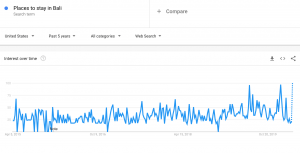
If you have a travel blog, “Places to stay in Bali” could be a great topic. It not only has the potential to increase long term organic traffic, it is also a great example of monetizable commerce content as you can earn commissions from affiliate programs such as Airbnb, Tripadvisor, Marriott, Hilton or Skyscanner for example.
For more inspiration, check our blog on great examples of commerce content.
2. Create a content strategy based on keyword research
A great way to start creating a content plan is to have a content strategy that is based on data.
By data, we simply mean keywords’ search volumes and SEO competition.
The first step is to look for topics and keywords your audience is looking for. If you are very familiar with your audience, ideas will come more naturally. If not, try thinking about the following:
- What are your audience’s biggest challenges?
- What are their interests?
- What products, tools or services are they using or looking for?
- What are the questions they are asking the most?
To get inspired, you can also try the following content research techniques:
- Searching for a relevant topic in Google and looking at Google’s “People also ask” and “Searches related to …” suggestions.
- Search for a keyword using Answerthepublic and export hundreds of topic ideas.
- Asking your audience directly what they would like you to write about.
- Joining Facebook groups, forums, Quora topics or subreddits relevant to your audience and look out for questions.
- Explore growing topics in your industry on Exploding Topics.
How to choose keywords for SEO
Once you have a list of keywords and content ideas, you can put them all into a spreadsheet and look for search volume data. To find keyword search volumes you can use Google Keyword Planner or Ubersuggest Keyword Ideas, which are both great (and free) SEO tools.
Once you have the volume for your blog ideas, you want to look at how difficult these keywords will be to rank for. To do this, you can use Ubersuggest to find the SEO difficulty score for each topic.
Once you have both search volumes and difficulty scores for each topic, prioritize the content to write about first based on potential (High search volume = High potential) and difficulty (High difficulty score = High difficulty).
The ideal topics to write about have a high potential score and a low difficulty score. These are the low-hanging fruit topics, and they should be showing up first in your content plan. Once you have sorted all your topics in order of priority using this method, you have got yourself a content plan!
To give an example of how your research could look like, let’s take the example of a blog on sustainability. In the table below you can see a list of keywords relevant to sustainable living that would be great for commerce content:
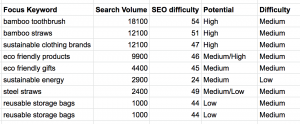
Search volume data in the United States (Source: Ubersuggest)
In this example, you can see that the first three topics have been prioritized because they have the highest potential (search volume) and have medium SEO difficulty scores. The topic on ‘Sustainable energy’ is also a good one to prioritize because it has a low difficulty score and so will be easier to rank for than the other topics.
To sum up, here’s a quick recap:
How do you create a content strategy?
- Understand your audience and come up with blog topics
- Gather data on keyword search volumes and SEO competition
- Create a content plan by prioritizing low-hanging fruit topics
3. Analyze the top SERP results for each topic
Now that you have your content strategy and blog topics plan mapped out, the next thing you’ll want to do is to look at SERP results. SERP stands for ‘Search Engine Results Pages’.
In other words, SERP results are a list of links to websites and blogs that are answering the searcher’s query.
The first few results are the ones who get the majority of the search traffic. It won’t be easy, but that is where you should aim to be.
So before you start writing your own blogs, it’s always good practice to look at the top results and understand why these pages are ranking high, but also how you can write a better piece of content so you can appear first.
What makes a blog good for SEO?
To illustrate this, we can take an example of a topic such as “Where to buy furniture”. When searching for this term in London (UK), the top 2 results are:
- London’s best furniture shops (timeout.com)
- Where to Buy Furniture in London (movingtolondon.net)
At first glance, both these blogs have a great title and URL that are short, easy to understand and include the target keywords people are searching for.
The two articles are also easy to read and useful to the reader (see Tip #4) with short paragraphs and links to the relevant furniture shops. Both sites are using Skimlinks affiliate links to earn commissions from online furniture orders that they refer to merchants such as IKEA or Argos.
Furthermore, Timeout makes clear the area and address of each furniture shop and includes images that help with the readability. On the other hand, the benefit that stands out while reading Moving To London’s post is that they categorize places to buy furniture based on price, quality or type (eg: Flea markets, charity shops, auction houses, etc).
As you can see, by looking at the top results in Google for each topic that you write, you can find out what types of content ranks the highest, understand why and use the learnings to write even better content to rank number 1. That brings us to Tip #4.
4. Write content that brings value
Every blog post that you produce needs to bring value to the reader. Your content needs to be useful and compelling enough for readers to keep reading. This means you should definitely focus on the quality of each blog more than the quantity of blog posts you produce.
Let’s take a look at a topic in the fitness industry as an example.
When searching on Google today for “best running shoes”, the number one result in the UK is an article by Runner’s World: The best running shoes 2020.
This post provides value as it provides exactly what information the reader is looking for, that is, the best running shoes you can find right now. They start by positioning themselves as experts on the topic and explaining how they choose the best running shoes so that you can too.
Runner’s World then start their list with the shoe they believe is the best and work their way down so you don’t have to scroll to the end to find the best shoes. They also provide a high-quality picture and a short description for each shoe, highlighting its features and benefits. They will even let you know if you need to go half a size up.
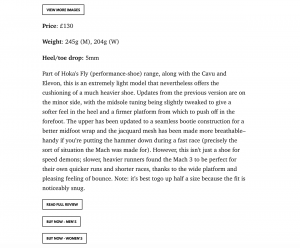
The price, weight and heel/toe drop are clearly listed, and they have several buttons (that look really natural) with links to more images and also to the full in-depth review page for each shoe. They also have ‘Buy Now’ buttons for both men and women, for which they use Skimlinks to automatically generate affiliate links.
Lastly, it’s worth pointing out that Runner’s World’s best running shoes list has 40 shoes in it. That’s pretty decent in terms of topical depth.
Google loves topical depth, which means they tend to prefer long blog posts because they enable Google to understand more precisely what each piece of content is about. If Google understands your posts, then they will rank them higher.
Google is also very attentive to dwell time (how long people stay on your page), so the more depth there is to your blog posts the better.
Knowing this, make sure your blog posts have at least 300 words. If you’re writing a very long blog post, try to maintain good readability by using short sentences and small paragraphs.
5. Use SEO friendly images
The first thing you should do before adding images to your website or blog is to reduce the file size of the image. This is important because images can slow down your page speed which can strongly influence SEO, and not in a good way. So make sure you use a free tool like Tinypng which will compress your PNG and JPEG images’ size without affecting the image quality.
The second thing you’ll need to do is add relevant keywords to the images’ file names and alt text. The alt text and file names should describe what the image is about.
For some extra SEO bonus points, try to have image alt text and file names that also have the target keywords you’re aiming to rank for. If you don’t know what to use you can always use your blog’s title.
With WordPress sites, you can easily edit the Alt text every time you upload an image. Otherwise, you can easily add Alt text to images by adding some HTML code. For example: <img src=”alt-text.png” alt=”Alt text in WordPress”>
6. Optimize meta descriptions and URLs
META descriptions are the short descriptions that show in search engine results. Just like this one for our blog on affiliate marketing tips:

Notice how we used the keywords affiliate marketing and tips for beginners in our description? That’s just another way to help Google understand what your content is about, and why you should always write your own META descriptions because they can help you rank higher. They can also improve your Click-Through-Rate (CTR), so it’s a no-brainer.
7. Do external and internal link building
Internal linking is simply the practice of inserting links into relevant keywords (also known as anchor text) within your blog post. For example, if we wrote a full blog post on internal link building, we should insert a link on the keyword “internal link building”.
Internal linking is not only helpful for readers, but it also keeps people on your blog for longer on your site and gives extra authority to your other blogs or website pages. You can also link to external links (other websites) as this can be a sign of a blog post’s quality and relevancy.
If you can find a way to get high authority websites linking to your blogs, that’s awesome. One strategy you can try is the Skyscraper Technique which involves searching for the type of content that gets the most backlinks in your industry, creating even better and more up-to-date versions of that content, and then reaching out to the websites linking to that content to let them know about it (and hope for a backlink).
8. Improve website page speed
Page speed is an important SEO ranking factor for both Google and Bing. A lot of things can impact your website’s page speed, the main ones are usually large images, themes, plugins or third-party code.
You can use the PageSpeed Insights tool to assess the speed performance of your website’s pages and blogs. With this tool, you can see what’s slowing down your site and make changes to your pages accordingly. You can also check Neil Patel’s Site Audit for more ideas on how to improve your website page speed.
9. Keep an eye on your blog’s analytics
Once you start making changes to your website and blogs to improve your SEO, it’s essential to know if those changes are actually working. You’ll want to create some simple and easy to read reports such as this one:
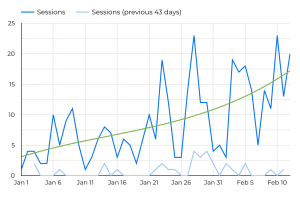
The report above was made using Google Analytics and Data Studio. It’s showing the number of the daily organic search traffic for one of our blogs. As you can see from the chart, it’s growing!
Want the same chart for your blog, right? To achieve this, it helps to set yourself a target for how much organic traffic you want to get and choose a deadline for when you need to reach that goal.
How to set SEO goals
For example, if you currently have 1000 monthly organic search traffic, your SEO goal could be:
“I want to increase my monthly organic search traffic to my blog by 30% (1300 organic traffic per month) by the end of this financial quarter.”
Once you have your goal, focus on the activities and ideas that will have the biggest impact to help you reach that target. These activities could be committing every week to publish 2 new blog posts, optimizing 1 existing blog and making 1 change to improve page speed for example.
Keep in mind that when you make changes to your website pages or publish a new blog post, it will take some time (usually around 3 to 4 weeks) to see a difference in traffic.
You can also use the Skimlinks page performance report to see which blog posts bring you the most impressions (traffic), and also the ones that make the most affiliate revenue. This will be useful to determine what type of content is performing well and doing more of what works.
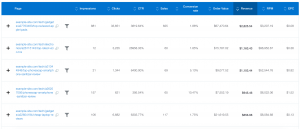
10. Stay up to date with Google updates
Google releases updates to its search engine algorithms around 8 to 10 times per year. It’s important to understand what changes come with each update so that you can adapt your SEO strategy accordingly and outsmart your competitors.
A good resource to use for this is Moz’s Google Algorithm Update History page, which has all the updates and main changes made by Google since the year 2000. To stay on top of Google updates you can also subscribe to podcasts and newsletters by Search Engine Journal, Moz or Yoast to name a few.
In one of Google’s recent updates, they introduced a new feature called FAQ Rich Snippets, which allows you to add a list of questions and answers to your Google search results’ listings. Early tests have shown that this simple hack can greatly improve your rankings and organic traffic.
This is just one example, out of many new changes happening to search engines every year, but it shows how you can quickly improve your SEO, and beat your competitors, by simply being on the lookout for new updates.
Ready to improve your SEO?
Now that you know how to improve your blog’s SEO, be sure to put your new skills into action straight away and always look for new ways to grow your organic traffic.
Just remember that by improving your SEO you will increase your blog’s traffic, and the 60,000 publishers using Skimlinks know that more traffic means more revenue!


